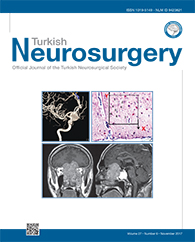2Medeniyet University, School of Medicine, Department of Histology and Embryology, Istanbul, Turkey
3Acibadem University, School of Medicine, Department of Neurology, Istanbul, Turkey
4Medipol University, School of Medicine, Department of Anesthesiology and Reanimation, Istanbul, Turkey
5Acibadem University, School of Medicine, Department of Pathology, Istanbul, Turkey
6Acibadem University, School of Medicine, Department of Physiology, Istanbul, Turkey DOI : 10.5137/1019-5149.JTN.17508-16.1 AIM: At the cellular level, spinal cord injury (SCI) provokes an inflammatory response that generates substantial secondary damage within the spinal cord but may also contribute to its repair. Besides intracellular antioxydant increase after exactly estimated oxidative stress; oxygen formation and transport is also advanced by ozone. The Wnt family of proteins contributes to the development of the nervous system, influencing cell proliferation. In the present study we evaluated the effect of ozone on spinal cord injury in rats.
MATERIAL and METHODS: Twenty-one male Sprague?Dawley rats were used. The rats were randomly allocated into three groups (control, trauma and trauma+ozone). SCI was inflicted using Allen"s spinal cord trauma method. The study was performed to determine the effects of ozone therapy on rats with SCI in terms of locomotor strength clinically and neuronal injury, white matter cavitation, edema, number of blood vessels, and expression of ?-catenin immunohistochemically.
RESULTS: Comparison of the locomotor strength scores revealed a significant improvement on day 7 in trauma+ozone group. The groups were compared with regard to edema, neuronal injury, and white matter cavitation. Average ?-catenin levels were significantly different between the control group (68.11 ± 0.43), trauma+ozone group (37.96 ± 2.16), and trauma group (25.46 ± 1.07) (F = 1677.74, df = 2, p < 0.0005).
CONCLUSION: The results of this study indicated that ozone therapy accelerates the healing process, increases vascularity, and reduces neuronal damage in rodents, suggesting that ozone therapy may be an adjuvant treatment in patients with SCI.
Keywords : Beta-catenin, Ozone therapy, Rat, Spinal cord injury, Wnt pathway




